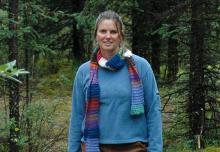Changing Tundra Landscapes
What Are They Doing?
Ms. Campbell worked with Donie Bret-Harte and a team of researchers who measured carbon, water, and energy fluxes at Toolik Field Station, Alaska. Their results were compared to findings from other arctic sites in Russia, Sweden, Greenland, and Canada to form a coordinated network of long-term observatories.
Laura Gough and John Moore investigated how climate warming affects arctic plant and soil communities both above and below ground. For example, as the Arctic continues to warm, soil nutrient availability will increase because the microbes are better able to decompose the organic matter present in the soil, releasing nutrients in the process. The team measured and compared a variety of factors in experimental and control plots in two different kinds of tundra. These data are crucial to understanding the long-term responses of these two communities and to predicting future changes.




